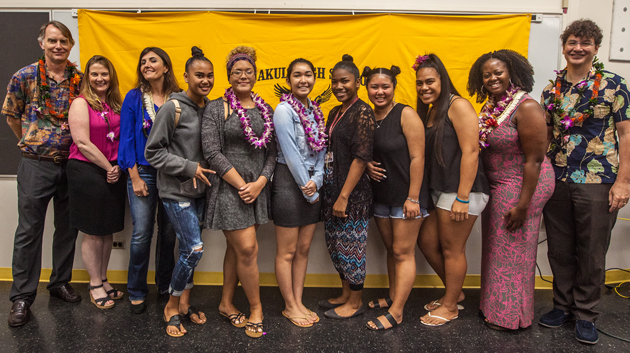
Nānākuli and Kapolei High Schools students were recognized for their outstanding student proposals, as part of the Maunakea Scholars program. These scholars will be awarded telescope time on Canada-France-Hawaiʻi Telescope, Subaru Telescope and Gemini Observatory.
Maunakea Scholars is an innovative program designed to bring Hawaiʻi’s young, aspiring astronomers into the observatory community by competitively allocating observing time on Maunakea’s world-class telescopes. This program is the first of its kind internationally, leveraging the most powerful collection of telescopes in the world for the direct educational advancement of local high school students.
For more on the Maunakea Scholars program go to the Canada-France-Hawaiʻi Telescope website.
Nānākuli scholars

Jasmine Atcherson will study a rogue planet with GNIRS at Gemini Observatory. She will use the world’s most sensitive infrared telescope to measure the composition of this free floating planet’s atmosphere.

Amber Nakata will research an eclipsing black hole binary system with Espadons on CFHT. Amber is the first Maunakea Scholar to receive three observing runs over a 6–9 month period. Combined, these data sets will allow Amber to monitor the time varying dynamics of the super heated gas falling into the black hole.
Attending the award ceremony was Canada-France-Hawaiʻi Telescope (CFHT) Director Doug Simons, Nānākuli Principal Darren Pilialoha, State of Hawaiʻi Department of Education Superintendent Kathryn Matayoshi, University of Hawaiʻi President David Lassner and CFHT Outreach Manager Mary Beth Laychak and Nānākuli teacher Jameeka Marshall.
Kapolei scholars

Chantelle Lopez will study the rogue planet GU Psc b with GNIRS at Gemini Observatory, searching for signs of weather on this rare free-floating planet.
Emily Little will research the comet 45P/Honda-Mrkos-Pajdusáková using Espadons at CFHT. She is searching for deuterated water to determine the source of water on earth.
Ashlyn Takamiya and Justin Fernando will study two supernova remnants using FOCAS at Subaru Telescope. They will use their data to determine if different supernovae mechanisms lead to the formation of different elements in the universe.
—Story from Maunakea Astronomy News

